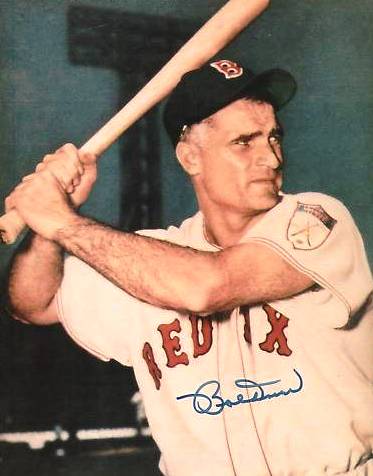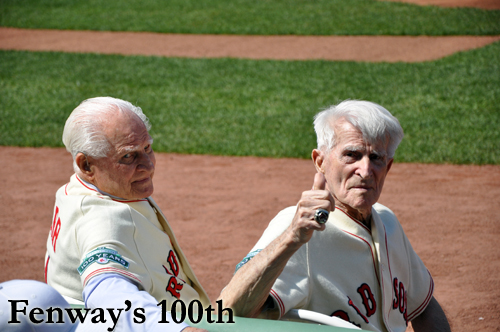I have no idea what happened to him. But the next year, another Bobby Doerr was elected to the Baseball Hall of Fame, along with Willie McCovey and the late Ernie Lombardi, and I was in Cooperstown, New York to watch the induction ceremony. As far as I know, the 2 Bobby Doerrs were not closely related.
Incidentally, if you ever want to visit the Hall of Fame, don't go during Induction Weekend. A town of 2,500 people simply wasn't designed to hold 100,000 tourists.
*
Robert Pershing Doerr was born on April 7, 1918, in Los Angeles. He began his professional baseball career as a 2nd baseman with his hometown Hollywood Stars, of the Pacific Coast League, in 1934 -- while he was a 16-year-old sophomore at L.A.'s Fremont High School. In 1936, the Stars traded him to another PCL team, the San Diego Padres, forerunners of the later National League team of that name. While there, one of his teammates was a San Diego native, Ted Williams. Their friendship would last for 66 years, as long as they both lived.
The Boston Red Sox bought Doerr's contract -- Williams' would have to wait -- and he made his major league debut on April 20, 1937, just 13 days after his 19th birthday. Wearing Number 9, the Red Sox number that Ted would later make legend, he was the leadoff hitter for the Red Sox on Opening Day, against Connie Mack's Philadelphia Athletics at Shibe Park
He struck out against Harry Kelley in the 1st inning, and flew out against him in the 2nd. That would be the highlight of Kelley's day, as the Sox smacked him around the yard. Doerr singled to center in the 4th, singled to left in the 5th, and beat out an infield single to 3rd in the 7th. The Red Sox won, 11-5, and Doerr was on his way.
Switching to Number 1, he led the American League in sacrifice hits in 1938. Williams arrived in 1939, and tried to teach Bobby, 4 months older and with 2 more years of major league experience, how to hit. Bobby said he knew. At his Hall of Fame induction ceremony, 47 years later, with Ted seated with the other Hall-of-Famers on the stage, Bobby told the audience (including yours truly) Ted's response: "Okay, if you want to be a lousy .280 or .290 hitter, that's your business!"
Bobby was a .318 hitter that season. In 1940, he had his 1st season of 20 home runs and his 1st of 100 RBIs. In 1941, he made the 1st of his 9 All-Star Games. He continued to hit well through the World War II years, including leading the American League with a .528 slugging percentage in 1944. The Department of War finally caught up with him, and he spent the 1945 season in the U.S. Army.
Ted had been in the U.S. Marine Corps. Both men returned in 1946, and Bobby's 111 RBIs and Ted's ferocious hitting led the Red Sox to their 1st Pennant since 1918, but they lost the World Series in 7 games. Ted won the AL MVP, Detroit Tiger pitcher Hal Newhouser (who'd won it the last 2 years) finished 2nd, and Bobby finished 3rd, the closest he would come to an MVP. Ted realized just how important the "lousy hitter" was to the team, calling him "the silent captain of the Red Sox."
Bobby hit 27 home runs, with 111 RBIs in 1948, but the Sox lost a 1-game Playoff for the Pennant to the Cleveland Indians. They came close again in 1949, but lost the last 2 games of the season, and thus the Pennant, to the Yankees.
In 1950, Bobby batted .294, led the AL with 11 triples, matched his career high with 27 home runs, and had a new career high with 120 RBIs. But, like his contemporaries Hank Greenberg, Ralph Kiner and Al Rosen, his career was cut short by a bad back. Despite making the All-Star Team in 1951, he retired, only 33 years old.
He finished with a lifetime batting average of .288 -- not "lousy" at all, unless you're Ted Williams -- 2,042 hits (if not for his injury, he could have made a run at 3,000), 381 doubles (a good total for any player, certainly for a 2nd baseman in the Pre-Expansion Era), 89 triples (ditto), 223 home runs (ditto), and a 115 OPS+. The Red Sox would retire his Number 1, and he was elected to the Baseball Hall of Fame, although he had to wait a while. So did Greenberg and Kiner. Rosen still hasn't been elected.
*
Doerr became a cattle rancher outside Junction City, Oregon. In 1957, the Red Sox brought him back as a scout. In 1961, he was named a minor-league hitting instructor. In 1967, new manager Dick Williams, who'd known him from managing the Triple-A Toronto Maple Leafs (for whom the better-known hockey team was named) the 2 previous seasons, made him his 1st base coach, thus making him part of the Sox' "Impossible Dream" season. Whatever Ted taught Bobby, he taught to Carl Yastremski, and "Yaz" won the Triple Crown and the MVP.
When Dick Williams was fired after the 1969 season, Bobby left the Sox. In 1977, the expansion Toronto Blue Jays made him their 1st hitting instructor, a post he held until 1981. His 1986 election made him the 1st man in a Jays uniform to make the Hall.
Bobby Doerr and Johnny Pesky,
his former double-play partner, Fenway Park, 1977.
He married Monica Terpin in 1938, and they had a son, and remained married until her death in 2003.
Following Ted Williams' death in 2002, and the 2003 publication of David Halbertsam's book The Teammates, a statue was erected on Van Ness Street, outside the 1st base stands Fenway Park. From left to right, it honors Johnny Pesky, Bobby, Ted and Dom DiMaggio. All but Ted lived to see its dedication.
All are gone now. Bobby Doerr suffered a stroke in 2011. He recovered enough to attend Fenway's 100th Anniversary celebration in 2012. He died yesterday, November 13, 2017, in Junction City, Oregon. At 99, he was the oldest living former Major League Baseball player, and the longest-lived member of the Baseball Hall of Fame.
Doerr and Pesky at the Fenway Centennial, April 20, 2012
UPDATE: He was buried at Rest Lawn Memorial Park in Junction City.
*
With Doerr's death, there are no more living men who played in MLB in the 1930s. Fred Caliguiri (debuted on September 3, 1941) and Chuck Stevens (September 16, 1941) are the only ones left to have debuted before Pearl Harbor was bombed, bringing America into World War II. Stevens is now the oldest former player: He would turn 100 next July 10, Caliguiri next October 22.
There are 13 remaining men who played in MLB during World War II: Caliguiri, Stevens, George Yankowski, Val Heim, Eddie Robinson (the last living 1948 World Champion Cleveland Indian and the oldest living former Yankee), Carl Scheib, Chris Haughey, Bill Mills, Eddie Basinski, Tommy Brown, Red Schoendienst (now the oldest living Hall-of-Famer and the earliest surviving Pennant-winning manager), Don Hasenmayer and Milt Welch.
And, 72 years after V-J Day, we are down to 37 men who are living veterans of both World War II and Major League Baseball: Caliguiri, Hasenmayer, Haughey, Heim, Robinson, Scheib, Schoendienst, Stevens, Cloyd Boyer, Bobby Brown (the last surviving 1947 and the last surviving 1949 World Champion Yankee), Dick Cole, Jack Crimian, Billy DeMars, Carl Erskine, Johnny Groth, Chuck Harmon, Johnny Hetki, Lefty Howard, Randy Jackson, Howie Judson, Dick Manville, Ed Mickelson, Larry Miggins, Bob Miller, Fenton Mole, Bobby Morgan, Irv Noren, Len Okrie, Marv Rackley, Ed Samcoff, Frank Saucier, Bobby Shantz, Charlie Silvera, Paul Stuffel, Wayne Terwilliger, Wally Westlake and George Yankowski. (Tommy Brown was too young to serve, Mills was 4-F, and I can't find a reason why Basinski and Welch didn't serve. They might have been 4-F, so don't judge them.)
As far as I can tell, the oldest living former players in the other sports are:
* NFL, Ben Agajanian, 98, played from 1945 (Philadelphia Eagles) to 1964 (San Diego Chargers). A placekicker in spite of a work accident that cost him the toes on his right foot (and kept him out of the service), he split the kicking duties with Pat Summerall on the 1956 NFL Champion Giants, and won another title, splitting the kicking duties with Paul Hornung on the 1961 NFL Champion Green Bay Packers. He not only played in the All-America Football Conference, the NFL, and the American Football League -- he and Hardy Brown were the only 2 players to do so -- but played for the Los Angeles team in each League: The AAFC's Dons in 1947 and '48, the NFL's Rams in 1953, and the AFL's Chargers in 1960 (before moving to San Diego in 1961, and he's now seen them move back to L.A.).
* NBA, Billy Gabor, 95, played with the Syracuse Nationals from 1948 until their 1955 NBA Championship season, after which he retired.
* NHL, John "Chick" Webster, just turned 97, played 14 games with the Rangers in the 1949-50 season, probably a victim of the "Original Six" setup that doomed him to being, otherwise, a career minor leaguer.
John Henderson debuted as a guard for the University of Texas in 1932, and has attended at least 1 home game every season since. He never played in the pros, but is believed to be the oldest living former college football player. If he makes it to Christmas Eve, he'll be 105.
The man believed to be the oldest surviving professional soccer player, at any level, is George Haigh, 102, of the Greater Manchester Area. He played from 1938 to 1946, mostly for local club Stockport County. Ignacio "Nacho" Trelles played in Mexican soccer from 1932 to 1949, mostly for Necaxa, and from 1946 to 1948 in America for the Chicago Vikings. He managed from 1950 to 1991, including the national team in 1975 and 1976. He won the top league with Marte in 1954, Zacatepec in 1955 and 1958, Toluca in 1967 and 1968, and Cruz Azul in 1979 and 1980. He is 101.
Aarne Kainlauri, 102, competed for Finland in the steeplechase footrace at the 1948 Olympics in London. South Londoner Bill Lucas, 100, also competed as a runner in those Olympics. John Lysak, born in Bound Brook, Somerset County, New Jersey, but raised in Yonkers, New York, was a canoeist in the 1936 Olympics in Berlin. Wilhelmina Schopman goes back further than that: She competed in a relay race for the Netherlands at the 1932 Olympics in Los Angeles. Now known as Mien Schopman-Klaver, she is 106. Also Dutch, Hans Maier, 101, was on the Dutch water polo team at the 1936 Olympics. The earliest living former Olympian appears to be Clara Marangoni, who turned 102 yesterday, and was an Italian gymnast at the 1928 Olympics in Amsterdam.
Mac Wilson is 103, and played Australian rules football in the 1943-44 season. Ken Feltscheer, 102, played in that sport from 1935 to 1943.
Eileen Whelan just turned 106, and the native of Highbury, the North London neighborhood that is home to Arsenal, is believed to be the oldest living former competitive cricketer, male or female. Thelma McKenzie, 102, is the oldest living Australian cricketer of either gender.
The oldest living male former cricketer appears to be John Manners of Hampshire Cricket Club on England's South Coast, 103. Hirendranath Sadhu played in India in the late 1930s and all through the '40s, including the war and independence years, and is 102. Jacqueline Vaudecrane, approaching her 104th birthday, won the French women's figure skating championships in 1937 and 1938.





No comments:
Post a Comment